SSZTC25 october 2015 LMT84 , TMP235 , TMP236 , TMP61
Choosing the right temperature sensor not only saves cost but also maximizes system performance. In this blog post, I’ll focus on negative temperature coefficient (NTC) thermistors, linear thermistors and analog temperature sensors, all of which are cost-effective temperature-sensing solutions. The problem is: how do you know which one to choose for your application?
NTC and linear thermistors are technically types of resistors that change their resistance with thermal conditions. Hence the name "therm+ister." A bias circuit and a few external components are required, as depicted in Figure 1, where a bias resistor and a thermistor form a voltage divider and connected to an optional operational amplifier that goes to a microcontroller's (MCU) analog-to-digital converter (ADC), thus converting the thermistor resistance to a temperature value.
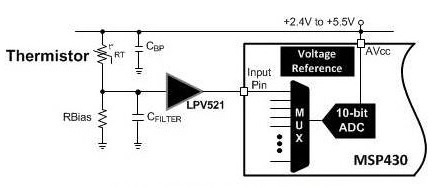 Figure 1 NTC Thermistor
Solution
Figure 1 NTC Thermistor
SolutionThe advantage of thermistors are their low cost. Also, as resistors, they can be put in a very small two-terminal package and into wired probes.
The disadvantage of an NTC thermistor is that its output is only linear for a narrow temperature range and remains non-linear across a wide temperature range. Figure 2 plots three output curves of an NTC thermistor that was biased with 1MΩ, 35kΩ and 10kΩ. Each curve is linear in a narrow temperature range, and the linearity gives way above 10ºC, 75ºC and below 50ºC for 1MΩ, 35kΩ and 10kΩ, respectively. Although specially calibrated NTC thermistors are available to accomplish the targeted accuracy for a specific temperature, they cost more, and maintaining these different devices makes inventory management extremely complex. Other disadvantages include unpredictable failure, noise sensitivity and higher power consumption.
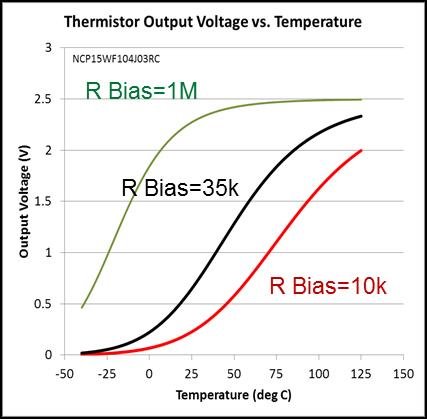 Figure 2 NTC Thermistor Output Voltage
vs Temperature
Figure 2 NTC Thermistor Output Voltage
vs TemperatureFor these reasons, NTC thermistors are most suitable for a narrow temperature range where unpredictability and power efficiency are not critical.
An analog temperature sensor is an active semiconductor device whose output is a voltage or current value proportional to a temperature. As an integrated circuit (IC), an analog temperature sensor has built-in smarts that NTC thermistors do not, making designing with an analog temperature sensor simple. Figure 3 shows a typical application of one of TI’s analog temperature sensors, using just the IC without external components.
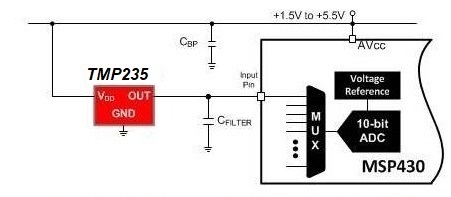 Figure 3 Example of an Analog
Temperature Sensor Solution
Figure 3 Example of an Analog
Temperature Sensor SolutionUnlike NTC thermistors, TI’s analog temperature sensors are accurate across a wide temperature range and have linear outputs across the entire operating range. You don’t need to worry about an inventory of different devices. Also, TI’s unique design allows these devices to have very low current and low noise sensitivity. As seen in Figure 4, which depicts the output of the TI LMT84 low-cost analog temperature sensor, its output is linear from -40ºC to 150ºC.
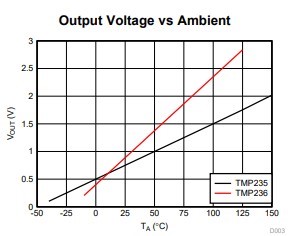 Figure 4 TMP235 and TMP236 Output
Voltage vs. Temperature
Figure 4 TMP235 and TMP236 Output
Voltage vs. TemperatureTo get the best of both worlds, there are linear thermistors like the TMP61. The TMP61 offers linear resistance change over the full temperature range and a linear slope, which gives a higher resistance value at higher temperatures. This means that the linear thermistor consumes less power than NTC thermistors at higher temperatures and doesn't have self-heating, therefore maintaining high accuracy at high temperatures.
Figure 5 shows the same device’s current consumption curves compared to a typical NTC thermistor. The LMT84 consumes 5µA (from -50ºC to 150ºC), while the respective NTC thermistor consumes from 101µA to 315µA.
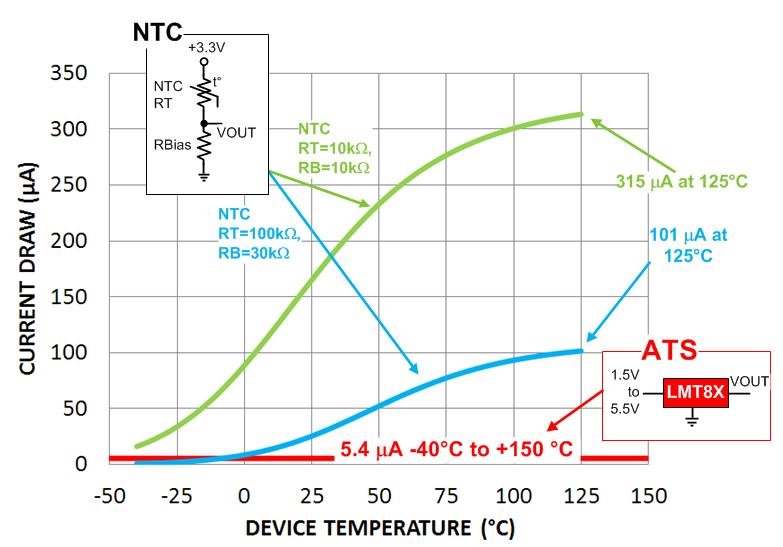 Figure 5 Power Dissipation – Thermistor
vs Analog Temperature Sensor
Figure 5 Power Dissipation – Thermistor
vs Analog Temperature SensorFigure 6 shows an analog temperature sensor vs. an NTC thermistor operating in a noisy environment by mounting both devices on a switching regulator. At room temperature, an NTC thermistor and sensor are at an equivalent noise level, but at hot temperatures, an NTC thermistor's noise level gets worse because it loses resolution. An analog temperature sensor is generally three times less noisy than an NTC thermistor. At these high temperatures, linear thermistors maintain sensitivity and therefore maintain resolution.
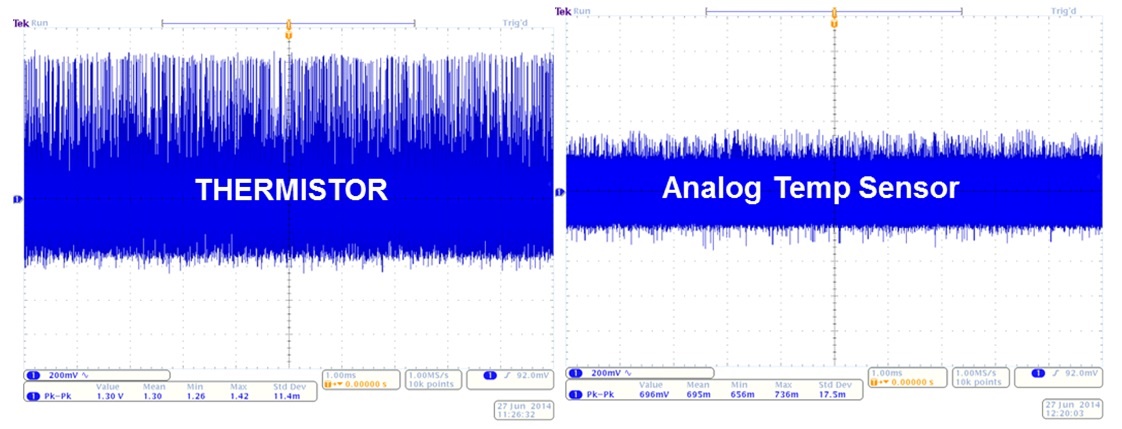 Figure 6 Noise Experiment of an NTC
Thermistor vs Analog Temperature Sensor Attached to a Switching
Regulator
Figure 6 Noise Experiment of an NTC
Thermistor vs Analog Temperature Sensor Attached to a Switching
RegulatorFor very narrow temperatures (typically between 0ºC and 70ºC), NTC thermistors can work well due to their narrow, quite linear range and cost effectiveness. Although specially calibrated NTC thermistors are available to accomplish the targeted accuracy for a specific temperature, they cost more, and maintaining these different devices can be an inventory nightmare. At the same price point, linear thermistors deliver high accuracy across a wide temperature range. Analog temperature sensors remove these challenges and are easy to use, accurate and very cost competitive. I invite you to share your experience and comment to let us know how you solve your system temperature sensing challenges. To learn more about TI temperature sensor portfolio and other applications, visit the links shown under additional resources below.
Additional Resources
- Read more blog posts about temperature sensing.
- Compare NTC and linear thermistor outcomes with our thermistor design tool.
- Learn more about TI’s sensing products.
- Join the temperature sensor forum to search for solutions and share knowledge about analog temperature sensors.